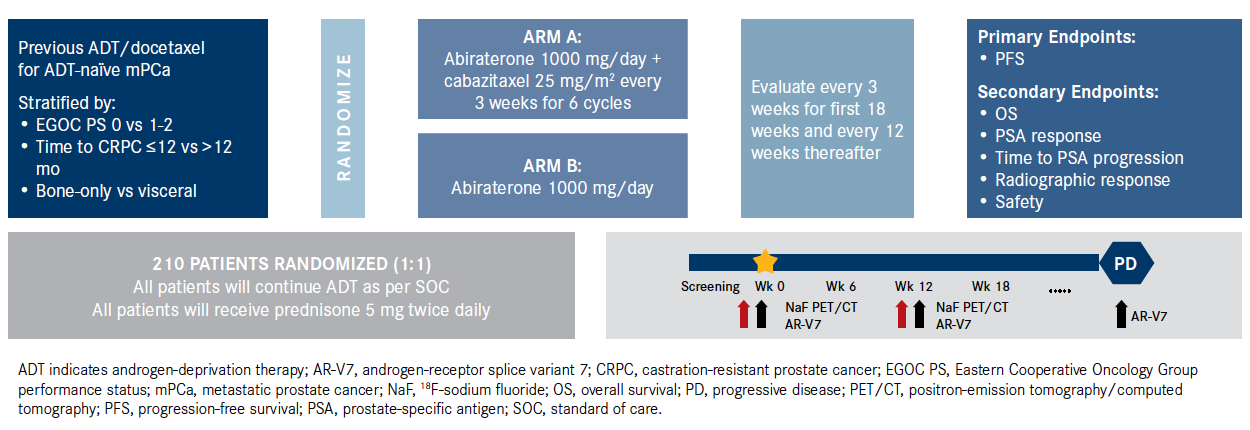The Prostate Cancer Paradox Revisited
Conflicting guidelines on prostate-specific antigen testing have affected trends on disease presentation and, potentially, the treatment outcomes for many men with this disease. New agents and powerful new imaging tools have added yet more complexity to the decision process. Therefore, more investigation and cooperation on multiple levels is needed to define appropriate standards of care.

Glenn Liu, MD
Professor of Medicine and Medical Physics
Leader of the Developmental Therapeutics Program and Genitourinary Oncology Research
Chair of the Prostate Cancer Subcommittee (ECOG-ACRIN)
University of Wisconsin Carbone Cancer Center in Madison
Conflicting guidelines on prostate-specific antigen (PSA) testing have affected trends on disease presentation and, potentially, the treatment outcomes for many men with this disease. New agents and powerful new imaging tools have added yet more complexity to the decision process. Therefore, more investigation and cooperation on multiple levels is needed to define appropriate standards of care.
Screening Under Scrutiny
Second to skin cancer, prostate cancer is the most common cancer in American men, and most will not die from it. They may either not need treatment, be cured, or die of nonprostate cancer—related causes. Concerns that this population may be overtreated resulted in a 2012 statement by the US Preventive Services Task Force (USPSTF) that PSA screening provides a “very small potential benefit” and “significant potential harms.”1 This led to a recommendation against PSA screening. This was the original prostate cancer paradox in which concerns about overdiagnosis resulted in more advanced disease at diagnosis and a potential negative impact on prostate cancer mortality. In 2018, a revised recommendation from the USPSTF acknowledged the value of screening in reducing death from prostate cancer and led to an increase in active surveillance.2 In this revision to the 2012 recommendation, the USPSTF emphasized the role of shared decision making to account for individual preferences. Trend: Less screening to avoid overdiagnosis.
Approximately one-third of men will develop recurrent prostate cancer after primary surgery or radiation therapy. The majority of these men are found to have a rising PSA, and for this population, early androgen-deprivation therapy (ADT) versus active surveillance are discussed as treatment options. Because the period from PSA increase to first metastasis found on conventional imaging (computed tomography [CT] and bone scintigraphy) can be up to 8 years, many patients and providers elect active surveillance to minimize the negative impact of treatment on quality of life (QoL), despite evidence that early treatment delays time to radiographic progression. Trend: Delayed treatment to preserve QoL.
The standard of care in men with metastatic prostate cancer has been ADT. Although the average duration of benefit is measured in years, eventually most patients will develop castration-resistant prostate cancer, which is the lethal form of the disease.3 Hussain et al tested the capability of intermittent ADT to “delay” castration resistance and improve QoL, and although the impact on survival was not noninferior, this study was important among early efforts to de-escalate systemic therapy in favor of maintaining QoL.3
Shifting the Treatment Paradigm Forward
In 2015, the results of the ECOG-ACRIN CHAARTED study showed that adding docetaxel to ADT improved overall survival (OS) by 13.6 months.4 The greatest benefit (17 months) was observed in men with high-volume metastases (defined as 4 or more osseous metastases with at least 1 extra-axial, or visceral, metastasis).
In 2017, the LATITUDE trial results showed that the addition of abiraterone acetate (Zytiga) plus prednisone to ADT in men with de novo metastatic prostate cancer with at least 2 high-risk features (Gleason score ≥8, ≥3 bone lesions, or measurable visceral metastasis) improved OS at least 18 months.5 More recently, data from the ARCHES trial presented at the 2019 American Society of Clinical Oncology (ASCO) Annual Meeting showed that adding enzalutamide (Xtandi) to ADT significantly delayed radiographic progression-free survival; results from the parallel ENZAMET trial showed improvement in OS (HR, 0.67; 95% CI, 0.52-0.86; P = .002).6 Of note, these studies did not limit enrollment to high-volume disease or de novo metastases. Finding: Earlier, more aggressive therapy improves survival.
The average survival gain appears consistent even though the CHAARTED trial used only 6 cycles of docetaxel up front and the other approaches require continued treatment with abiraterone or enzalutamide. From a tumor-modeling standpoint, this raises interesting questions: One hypothesis is that early cytoreduction may result in treatment of intrinsically resistant clones, which translates to long-term survival; a competing hypothesis is that delaying treatment of emerging resistance provides the benefit. It should not be a surprise that ongoing trials (PEACE1, STAMPEDE, ARASENS) are more specifically addressing the role of chemotherapy in combination with newer androgen-signaling pathway inhibitors (2 vs 3 drugs).
Breaking the Cycle of Overtreating Patients
We are now at our second paradox, where the approach that less is more has now reversed to suggest that more is better, at least in men with early metastatic disease. While advanced PET imaging can now detect earlier metastases in the setting of a rising PSA, how does this change practice? We have gone from delaying treatment in men to preserve QoL, to adding early docetaxel chemotherapy in men with extensive disease (defined partly by number of lesions) and abiraterone in de novo disease with high-risk features. We are now using enzalutamide in any individual with metastatic prostate cancer. All things considered, advanced imaging is going to identify more lesions (eg, if the number of lesions is most important) and find more lesions at time of diagnosis or at time of PSA relapse (eg, if the timing of therapy is most important). This leaves our patients with a dilemma: when to start and which therapy to use, which is contrary to the original paradox about de-escalating care in order to preserve QoL. Certainly, the risk of cancer-related mortality is higher in men with metastatic prostate cancer, justifying the added cost and diminished QoL, and there are clearly men who will benefit from more aggressive, earlier treatment. On the other hand, there are men for whom active surveillance, or ADT alone, poses a very low risk for prostate cancer mortality.
Figure. CHAARTED2 Evaluates Repeated Chemotherapy-Hormonal Therapy in Progressive mCRPC8 (Click to Enlarge)

The Future of Care
Although clinical trials lead to treatment recommendations on a population level, they do not necessarily reflect the best course of therapy for an individual. We are at a time where cost and quality of care are vital considerations, and with the rising costs of drugs and number of drugs available, the use of advanced diagnostics and treatment response tools can now be financially justified.
Robert Jeraj, PhD, and I have been collaborating on the development of treatment response tools that incorporate advanced PET/CT imaging in men with metastatic prostate cancer. With support from the University of Wisconsin Carbone Cancer Center, Prostate Cancer Foundation, and US Department of Defense, we have developed quantitative total bone imaging (QTBI) as a platform that will automatically identify metastasis (volume and distribution), functional activity (burden), and quantitative change (treatment response) in the skeleton.7
We have long appreciated that biologic heterogeneity is present among individuals (interpatient), but heterogeneity present within an individual (intrapatient) is underrecognized. In partnership with Pfizer, we have tested the role of QTBI in identifying patients with intrinsically resistant lesions and those who develop acquired resistance on treatment. As reported at ASCO 2019, we showed that when interlesional response heterogeneity is present within a patient, it may identify those with suboptimal responses who may benefit from a more aggressive systemic approach, as well as those with oligoprogressive lesions where ablative therapy to nonresponding lesions may be preferred. QTBI is currently incorporated in CHAARTED2 (EA8153; NCT03419234), in which the benefit of repeated chemo-hormonal therapy (eg, abiraterone plus/minus cabazitaxel [Jevtana]) is being evaluated in patients who have progressed on CHAARTED therapy (Figure).8
Why is this important? Significant improvements in prostate cancer treatment options have led us full circle to once again risk overtreatment of some men with this disease. Although newer therapies are rapidly advancing, the general approach to assess treatment response has not significantly changed in decades. Advanced PET imaging (fluciclovine F18 [Axumin], gallium-labeled prostate-specific membrane antigen, and 18F-sodium fluoride) is becoming more widely available, but how to use these tools to assess disease burden or treatment response remains undefined. Nevertheless, these tools have the potential to improve treatment decisions for individual patients. Support is needed from pharmaceutical companies, academic centers, and community oncologists to populate imaging registries in order to advance understanding of advanced imaging and develop treatment response tools. It is our hope that these tools will allow practitioners to avoid over- or undertreatment, maximize the benefit from existing therapies, and individualize cancer care.
Acknowledgment: Dr Liu is a co-founder of AIQ Solutions of Madison, Wisconsin, which has licensed QTBI technology. He serves as a consultant to AIQ. He is also co-inventor of the following patents: US 9161720 and US 9603567.
Question: How many men will be overtreated again?
References
- US Preventive Services Task Force. Archived final recommendation statement: prostate cancer: screening. USPSTF website. uspreventiveservicestaskforce.org/Page/Document/RecommendationStatementFinal/prostate-cancer-screening. Updated May 2012. Accessed August 16, 2019.
- US Preventive Services Task Force. Final recommendation statement: prostate cancer: screening. USPSTF website. uspreventiveservicestaskforce.org/Page/Document/RecommendationStatementFinal/prostate-cancer-screening1. Updated May 2018. Accessed August 16, 2019.
- Hussain M, Tangen CM, Berry DL, et al. Intermittent versus continuous androgen deprivation in prostate cancer. N Engl J Med. 2013;368(14):1314-1325. doi: 10.1056/NEJMoa1212299.
- Sweeney CJ, Chen YH, Carducci M, et al. Chemohormonal therapy in metastatic hormone-sensitive prostate cancer. N Engl J Med. 2015;373(8):737-746. doi: 10.1056/NEJMoa1503747.
- Fizazi K, Tran N, Fein L, et al; LATITUDE Investigators. Abiraterone plus prednisone in metastatic, castration-sensitive prostate cancer. N Engl J Med. 2017;377(4):352-360. doi: 10.1056/NEJMoa1704174.
- 6. Davis ID, Martin AJ, Stockler MR, et al; ENZAMET Trial Investigators and the Australian and New Zealand Urogenital and Prostate Cancer Trials Group. Enzalutamide with standard first-line therapy in metastatic prostate cancer. N Engl J Med. 2019;381(2):121-131. doi: 10.1056/NEJMoa1903835.
- Liu G, Perlman S, Perk T, et al. Quantitative total bone imaging in patients with metastatic castration-resistant prostate cancer. J Clin Oncol. 2017;33(suppl 15):e16016. doi: 10.1200/jco.2015.33.15_suppl.e16016.
- Kyriakopoulos C, Heath EI, Ferrari AC, et al. Interlesional response assessment with 18F-sodium fluoride (18F-NaF) PET/CT in men with chemotherapy-naive bone metastatic castration-resistant prostate cancer (mCRPC) treated with enzalutamide (ENZA). J Clin Oncol. 2019;37(suppl 15): 5036. doi: 10.1200/JCO.2019.37.15_suppl.5036.




